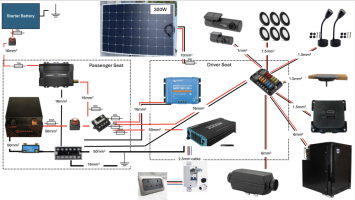Hi all,
I'd REALLY appreciate some feedback on the below - I've spent many, many hours researching this, but having not done it before the learning curve is steep. I'm new here, so I'll start with a photo of the van....

Right, onwards!
Use Cases
The van will predominantly be used as a day van (most weekends all year round). It will do longer family trips of a week or more where we aren't sleeping in the van.
I will use it myself as a 'base' for triathlons and other similar events, sleeping in the van and cooking/eating in it as well as charging devices and occasionally working from it. I know it's a complex subject but some kind of coffee machine is a must! It will be static for no more than 48hrs.
Neither of the above use cases see me using an electrical hookup at any point.
It is important to build in resilience and growth capacity - I will keep this van for a long time and may start camping in it for longer periods.
Wiring Plan

I know that's a mess, so explaining it in words...
Components
Leisure Battery - Roamer Seatbase 230Ah
Positive - 300A fuse, 50mm2 cable to an isolator and then a distribution box
Negative - 50mm2 cable to the Victron SmartShunt 300A and on to a negative busbar
DC-DC Charger - Renogy 40A DC-DC Charger
Connected to the distribution box via a 60A fuse and 16mm2 cable, and on to the negative busbar by 16mm2 cable
MPPT - Victron 100|30
Connected to a 300W solar panel by a 10mm2 cable and 30A fuse, to the distribution box by a 16mm2 cable and 60A fuse, and to the negative busbar by a 16mm2 cable.
Inverter - Renogy 2000W
Connected to the distribution box via a 250A fuse and 50mm2 cable, and to the negative busbar by 50mm2 cable
Connected to two three pin plugs by a 2.5mm cable via a consumer unit.
12V Fuse Block
Connected to the following, all by 1.5mm2 cable:
Some specific questions

I'd REALLY appreciate some feedback on the below - I've spent many, many hours researching this, but having not done it before the learning curve is steep. I'm new here, so I'll start with a photo of the van....

Right, onwards!
Use Cases
The van will predominantly be used as a day van (most weekends all year round). It will do longer family trips of a week or more where we aren't sleeping in the van.
I will use it myself as a 'base' for triathlons and other similar events, sleeping in the van and cooking/eating in it as well as charging devices and occasionally working from it. I know it's a complex subject but some kind of coffee machine is a must! It will be static for no more than 48hrs.
Neither of the above use cases see me using an electrical hookup at any point.
It is important to build in resilience and growth capacity - I will keep this van for a long time and may start camping in it for longer periods.
Wiring Plan

I know that's a mess, so explaining it in words...
Components
Leisure Battery - Roamer Seatbase 230Ah
Positive - 300A fuse, 50mm2 cable to an isolator and then a distribution box
Negative - 50mm2 cable to the Victron SmartShunt 300A and on to a negative busbar
DC-DC Charger - Renogy 40A DC-DC Charger
Connected to the distribution box via a 60A fuse and 16mm2 cable, and on to the negative busbar by 16mm2 cable
MPPT - Victron 100|30
Connected to a 300W solar panel by a 10mm2 cable and 30A fuse, to the distribution box by a 16mm2 cable and 60A fuse, and to the negative busbar by a 16mm2 cable.
Inverter - Renogy 2000W
Connected to the distribution box via a 250A fuse and 50mm2 cable, and to the negative busbar by 50mm2 cable
Connected to two three pin plugs by a 2.5mm cable via a consumer unit.
12V Fuse Block
Connected to the following, all by 1.5mm2 cable:
- Dash cam
- LED roof lights
- Reading lights with USB
- Wireless Charger
- USB sockets
Some specific questions
- I am particularly unsure on my cable sizes and fuse ratings - I think have gone overkill on cables in some places to reduce the number of different gauges I need though.
- Should I have a negative busbar under each seat to reduce cable runs?
- Should I wire the dashcam to the distribution box or is it easier to hard wire it to the van some other way?
- Where should I physically put the isolator by the starter batter and under the passenger seat so it is accessible (but not accidentally tripped?)
- I am installing a slimline kitchen. Would I be better putting elements of this (12V fuse block especially) inside a cupboard where it is more accessible?


